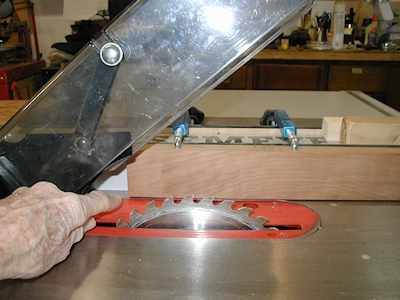Location of Rip Fence on a Table Saw or Band Saw:
Created: April 6, 2023
Last Revised: October 23, 2023
French Creek Valley Home
Back to My Woodshop
Blacksmithing
Contact Us
I used to locate my rip fences so they spanned the length of the saw table.
The rip fence on my table saw spans the whole depth of the table.
So there's about a foot of fence on the front side of the blade and about a foot of fence on the back side of the blade.
Pretty normal, right?
Well, that's okay as long as the boards I am ripping don't have any stresses in them that are relieved when I saw them.
But, for me, anyway, many boards DO have stresses in them. And, usually, when I saw them, the sawn ends seem to bend AWAY from each other.
This condition often causes the unsawn part of the board the be slightly pushed away from the fence making the portion of the board thinner than intended.
So I added a exactly one inch thick piece of wood to the fence and positioned it so that it ENDS just at the rear edge of the saw blade.

Now, if the board does spring open on me, it doesn't affect the alignment of the unsawn part of the board that I am ripping.
Maybe this doesn't sound important if accuracy isn't a big deal, but it sure made my life easier.
Several years later, when reviving an old 36" bandsaw, I made the same mistake when I built my own rip fence for that machine.
The whole reason for obtaining that band saw was for resawing boards as wide as a foot or more down to as thin as 1/4" or less,
so the bowing or springing issue was/is important.
So, after realizing that what I thought was "blade drift" was really being caused by stresses in the boards,
I moved that fence so that it extends only about on inch beyond the blade.

---And, lo and behold, problem solved!
I am no expert at anything, but I suspect that this problem may become more noticeable on boards that have recently
been jointed and/or planed on one or both sides.